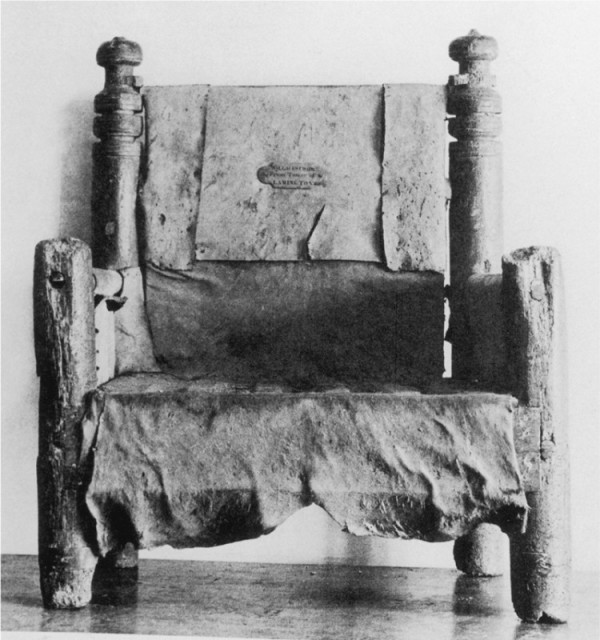
Great chair, England, 1300–1400. Materials and dimensions not recorded. (Antiques 32, no. 3 [September 1937]: 112–13.) The leather covers are later additions and many of the small components are replacements.
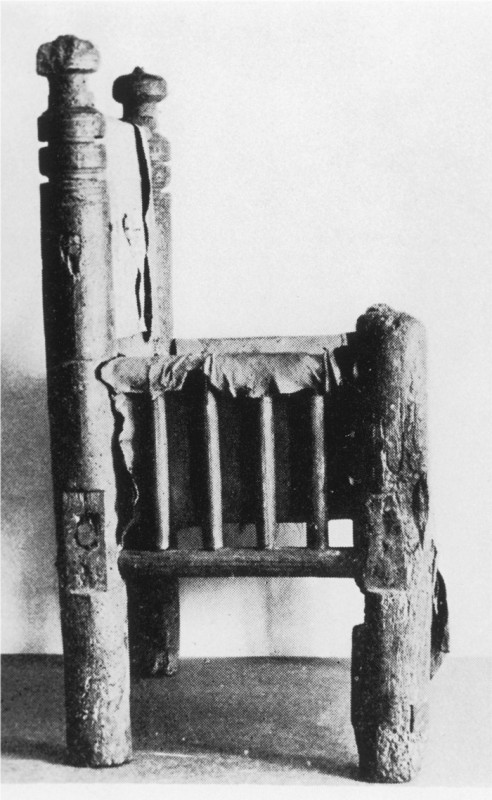
Side view of the chair illustrated in fig. 1.

Rear view of the chair illustrated in fig. 1.

Diagram showing the seat rail construction of the chair illustrated in fig. 1. The seat boards are thick and do not have feathered edges.
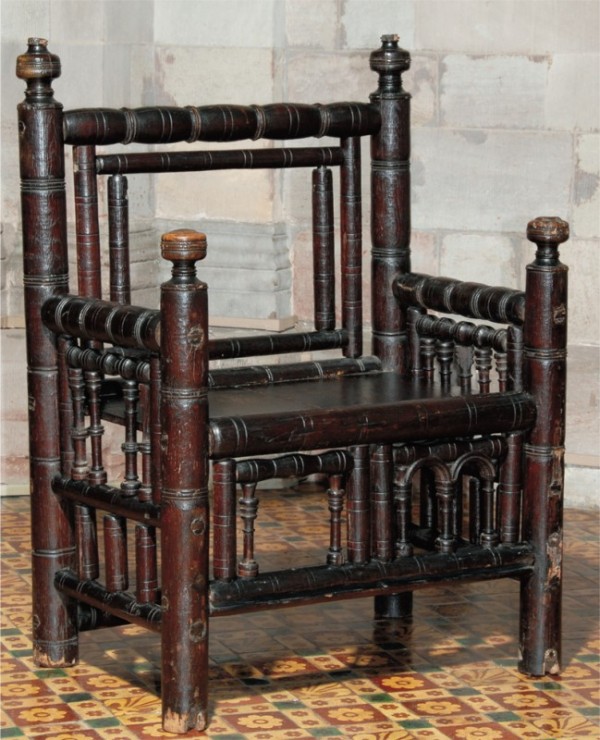
Great chair, England, 1300–1400. Oak. Dimensions not recorded. (Courtesy, Dean and Chapter of Hereford Cathedral.)
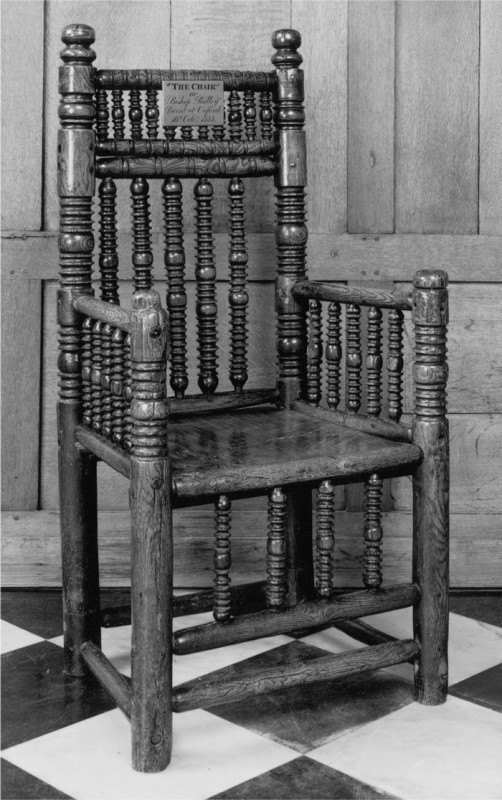
Great chair, probably London, 1540–1550. Elm. H. 46 1/4", W. 23 1/2", D. 18 5/8". (Courtesy, Pembroke College, Cambridge; photo, James Austin.) The rear feet are pieced, the lower back rail is replaced, the rear seat rail groove has split out, and two slats nailed underneath reinforce the seat boards. The seat boards are not held in the side seat rails. The front and rear seat rails are pegged, and all the mortises are through-bored. The crest rail originally had fifteen applied buttons.
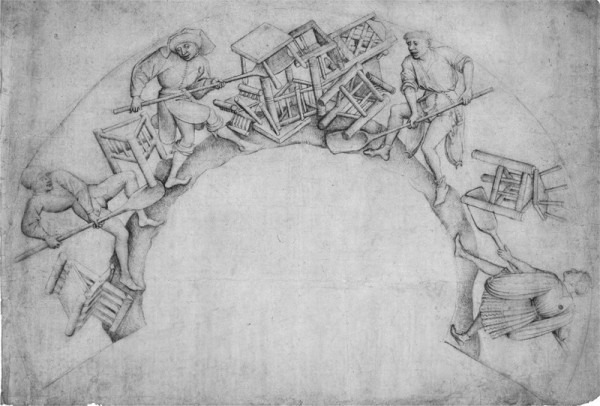
Men Shoveling Chairs (Scupstoel), Circle of Rogier van der Weyden, Flemish, 1444–1450. Pen and brown ink over traces of black chalk. 1 13/16" x 16 3/4". (Courtesy, Metropolitan Museum of Art, Robert Lehman Collection, 1975 [1975.1.848]. Image © Metropolitan Museum of Art.)
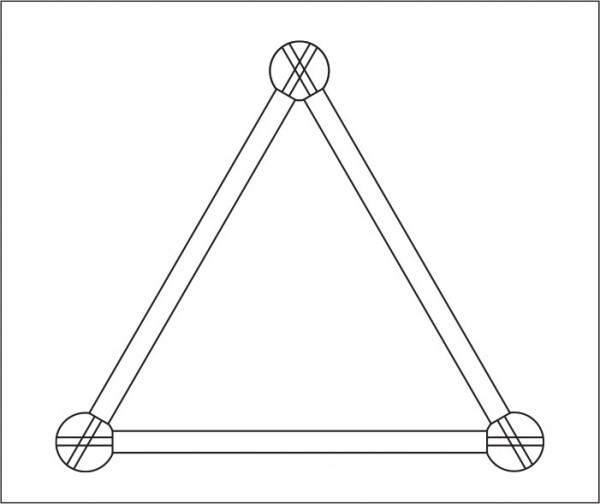
Diagram showing the placement of square and round tenons in the frame of a triangular stool.
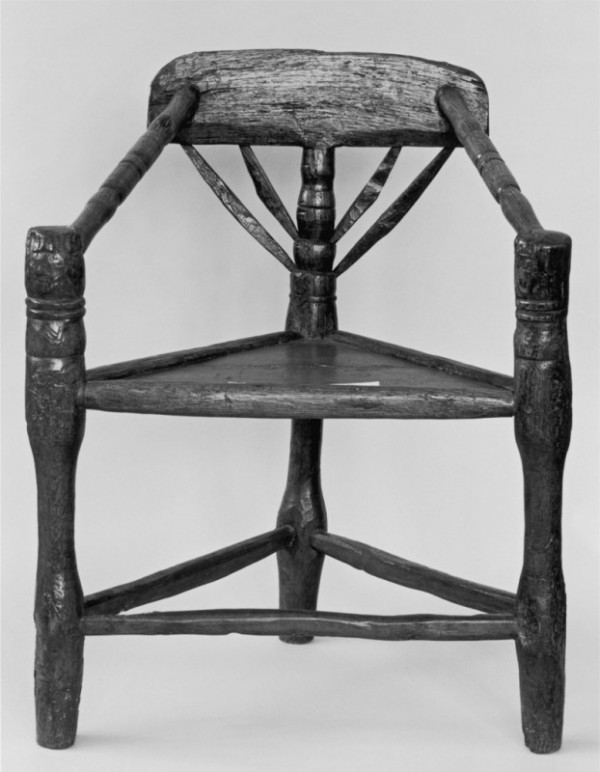
Great chair, England or the Netherlands, 1500–1650. Possibly fruitwood and beech. H. 31", W. 24", D. 18". (Private collection; photo, National Trust, Northwest Region, Cumbria.)
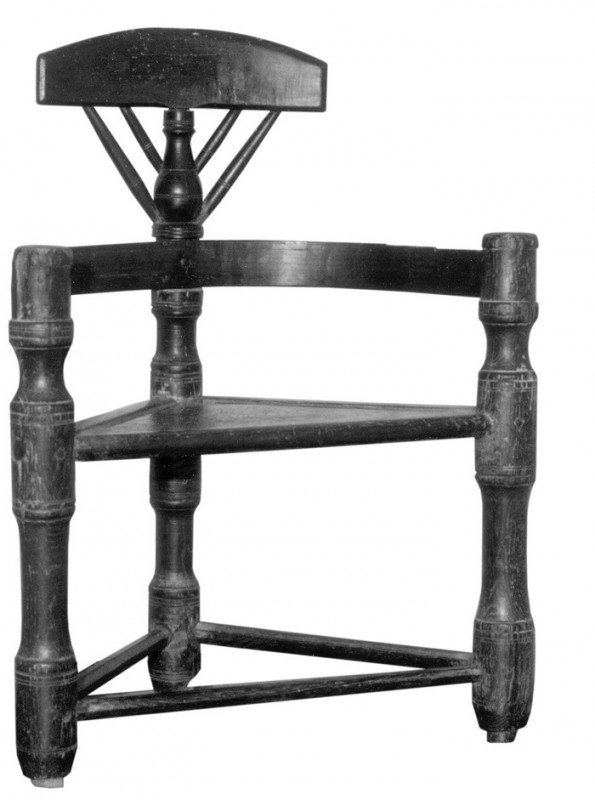
Great chair, South Africa, eighteenth century. Possibly stinkwood. H. 32", W. 23 3/4", D. 15 1/2". (Private collection; photo, H. K. J. Roos.)
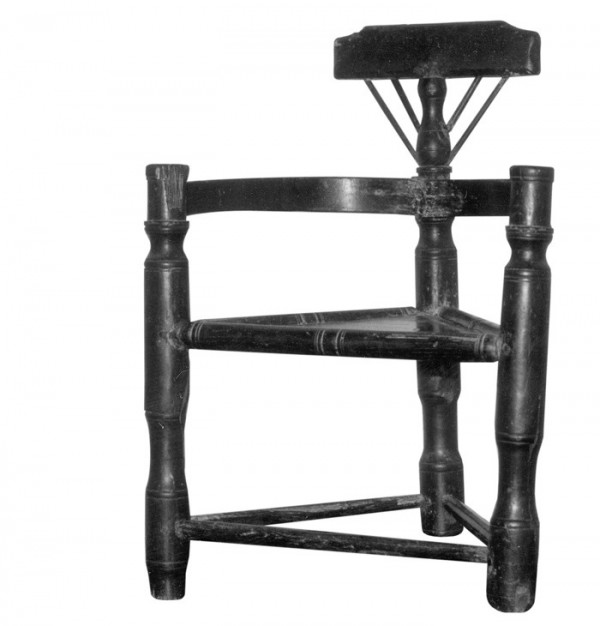
Great chair, South Africa, eighteenth-century. Possibly stinkwood. H. 31", W. 22 3/4", D. 15 1/2". (Private collection; photo, H. K. J. Roos.)

Great chair, England, 1600–1650. Ash and possibly elm or yew. H. 35", W. 23", D. 17 3/4". (Private collection; photo, Robert J. Bitondi.) The side stretcher nearest the viewer is pulled up at the rear to such an extent that it is not parallel to the seat rail above it.
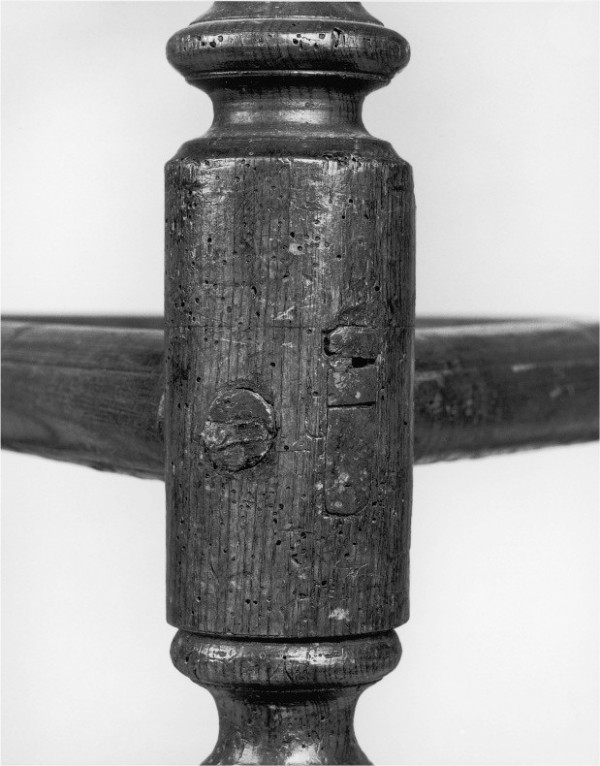
Detail of the left front post of the chair illustrated in fig. 12. The small round tenon pierces the rectangular tenon and is back-wedged.

Detail of the left seat joint of the chair illustrated in fig. 12. The shoulders of the front seat rail are sawn on the bias to conform to the post. The seat board is extremely snug. On some chairs of this type, the corners of the seat board fit into a slight groove incised in the post.
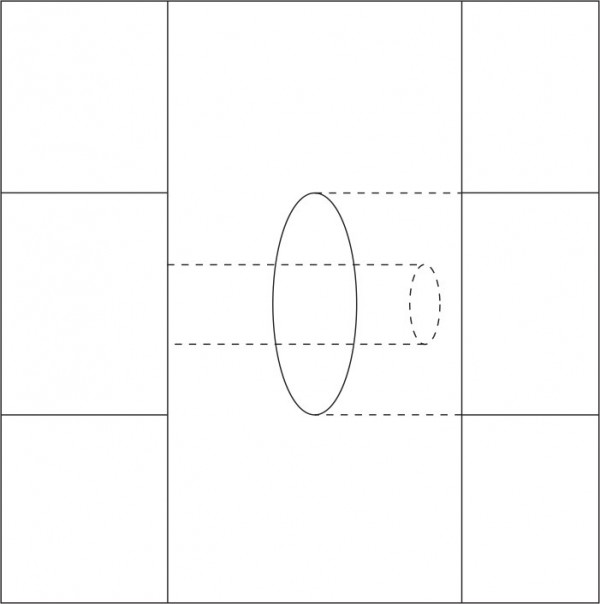
Diagram showing the seat rail joint of a board-seated chair with intersecting round tenons.

Great chair, Wales, 1550–1660. Woods not recorded. H. 39", W. 26", D. 21". (Courtesy, Museum of Welsh Life, St. Fagan’s, Cardiff, Glamorgan; photo, Robert F. Trent.) The seat board is made in two pieces and the seat rails have a round tenon at one end and a rectangular tenon at the other.

Great chair, Wales, 1550–1650. Yew and oak. H. 38 1/8", W. 25 1/2", D. 20 1/2". (Courtesy, Museum of Welsh Life, St. Fagan’s, Cardiff, Glamorgan; photo, Robert F. Trent.) The seat board is made in two pieces and the seat rails have a rectangular tenon at one end and a round tenon at the other. The shoulders of the rectangular tenons are cut on the bias to conform to the shape of the posts. Some of the applied finials and the left upper arm are replacements.

Great chair, Wales, 1550–1650. Elm and oak. H. 57 1/4", W. 28", D. 22 3/4". (Courtesy, Museum of Welsh Life, St. Fagan’s, Cardiff, Glamorgan; photo, Robert F. Trent.) The seat board is made in two pieces and the seat rails have a large round tenon at one end and a small round tenon at the other. The arm joints and the entire back superstructure are extensively pinned. The turned buttons on the crest have round tenons that were shaved square before being forced into smaller, round mortises. The buttons are not pinned, which suggests that the crest rail retained considerable moisture at the time of manufacture and the maker expected the mortises to shrink around the tenons.
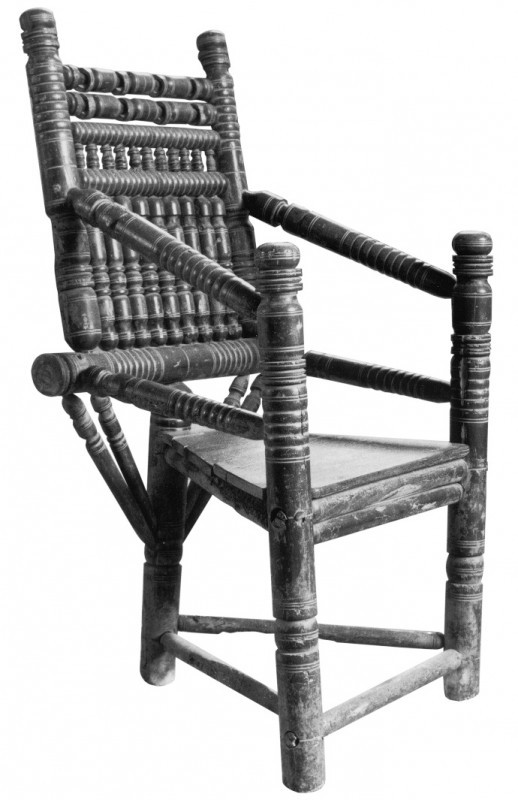
Great chair, Cornwall or Devon, England, 1550–1650. Ash. H. 45", W. 23 7/8", D. 26 1/2". (Courtesy, Church of St. Marnarch, Lanreath, Cornwall; photo, Robert F. Trent.) The seat is an incorrect replacement installed on top of the seat rails. The right seat rail is replaced.
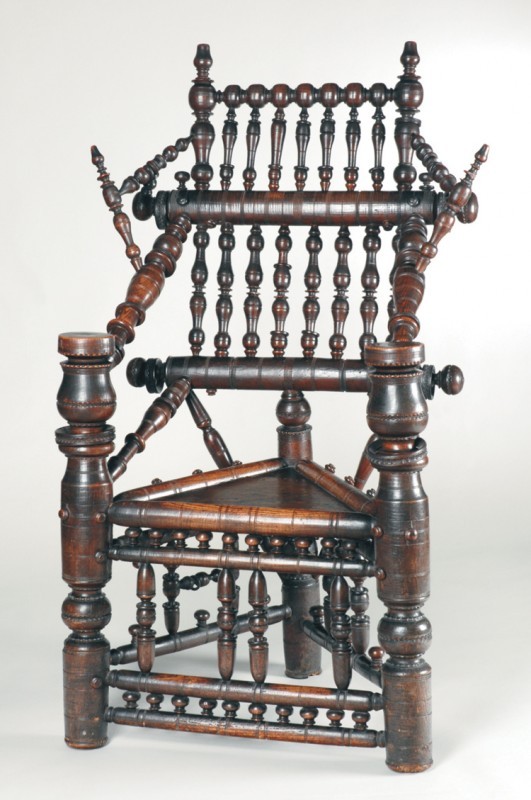
Great chair, Wales, 1550–1650. Elm. H. 53 5/8", W. 33", D. 26 1/8". (Courtesy, Temple Newsam House, City of Leeds, Yorkshire; photo, Norman Taylor.)

Great chair, Wales, 1550–1650. Elm. H. 52 7/8", W. 31 3/4", D. 25 1/2". (Courtesy, Museum of Welsh Life, St. Fagan’s, Cardiff, Glamorgan; photo, Robert F. Trent.) The upper and lower arm joints are pinned; the intermediate arms are not pinned. The left rear leg, seat rails, upper front stretcher, upper left arm, and seat board are replacements. The finials on the back posts are enlarged versions of the small, applied buttons on the top of the crest rail, and the footrest is a later addition.

Great chair, Wales, 1550–1650. Ash and oak. H. 44 7/8", W. 30 3/8", D. 22 3/8". (Private collection; photo, George Fistrovich.) This object is part of a large group of almost identical chairs, including an example acquired for the president of Harvard College in the mid-eighteenth century.
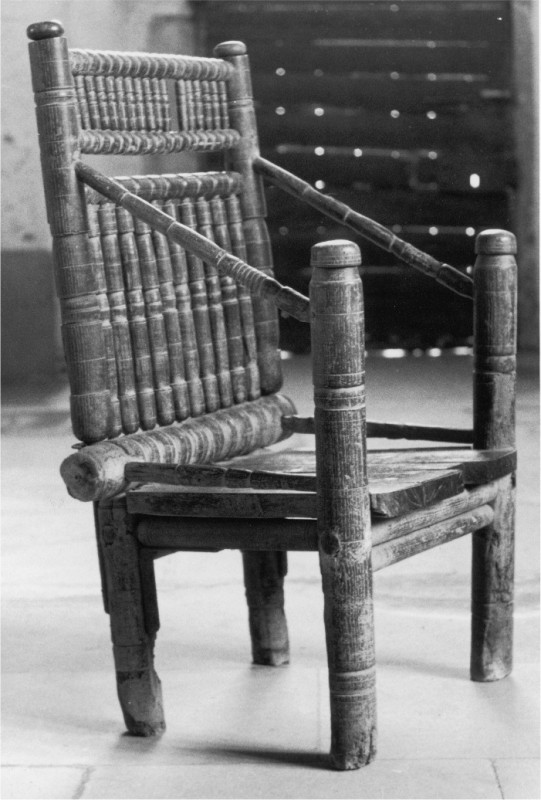
Great chair, Cornwall, England, 1550–1650. Ash. H. 41", W. 25 3/8", D. 19 3/8". (Courtesy, Church of St. Marnarch, Lanreath, Cornwall; photo, Robert F. Trent.) The seat boards are incorrect replacements installed atop the seat rails, and the finials are restored.
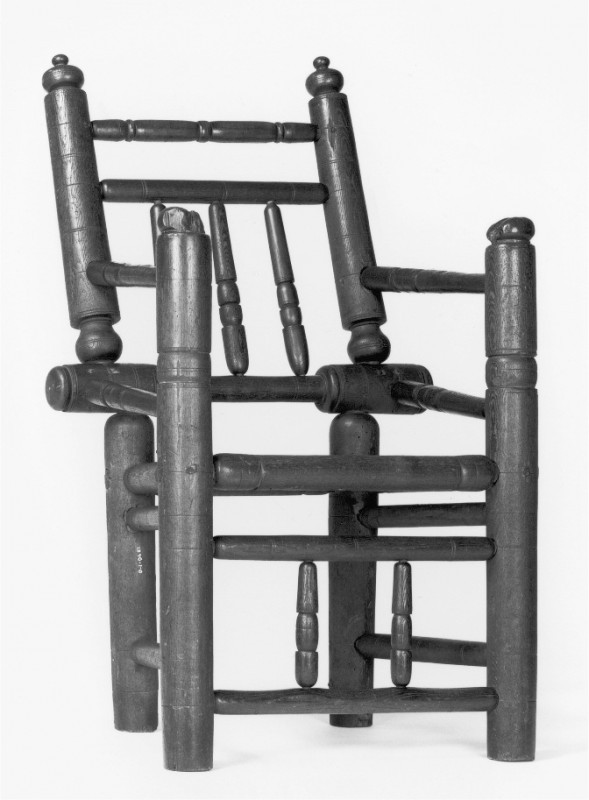
Great chair, probably Wethersfield, Connecticut, or New York City, 1650–1700. Ash and oak. H. 41 1/8", W. 26", D. 20". (Courtesy, Connecticut Historical Society, Hartford, Connecticut; photo, Robert J. Bitondi.)

Side view of the chair illustrated in fig. 24, showing the angle at which the back is set in the low structural bar.
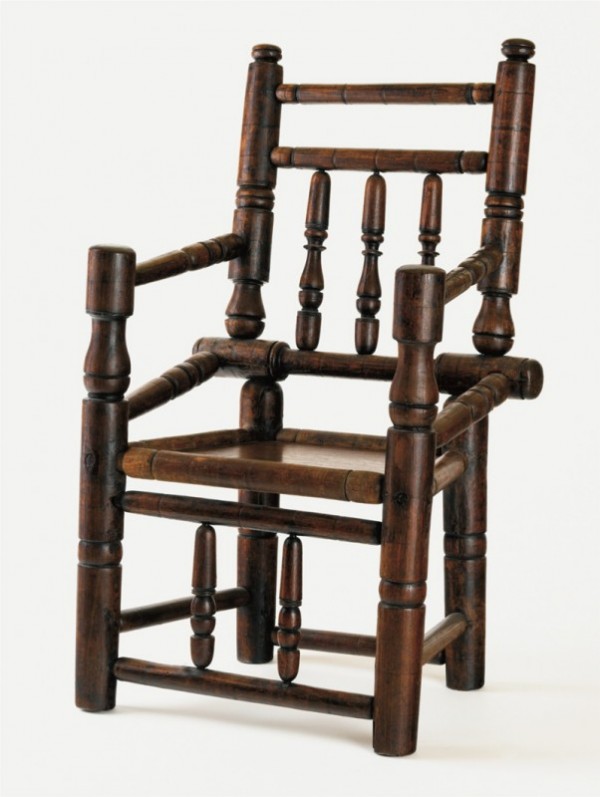
Great chair, New York City, 1650–1700. Ash and oak. H. 39 1/2", W. 24", D. 17". (Courtesy, Metropolitan Museum of Art, Rogers Fund, 1941 [41.111]; photo, Gavin Ashworth.) The seat board is a modern replacement.

Great chair, Connecticut or New York, 1650–1700. Maple and ash. H. 43 1/2", W. 23" (front) and 17" (rear), D. 16". (Private collection; photo, Gavin Ashworth.)
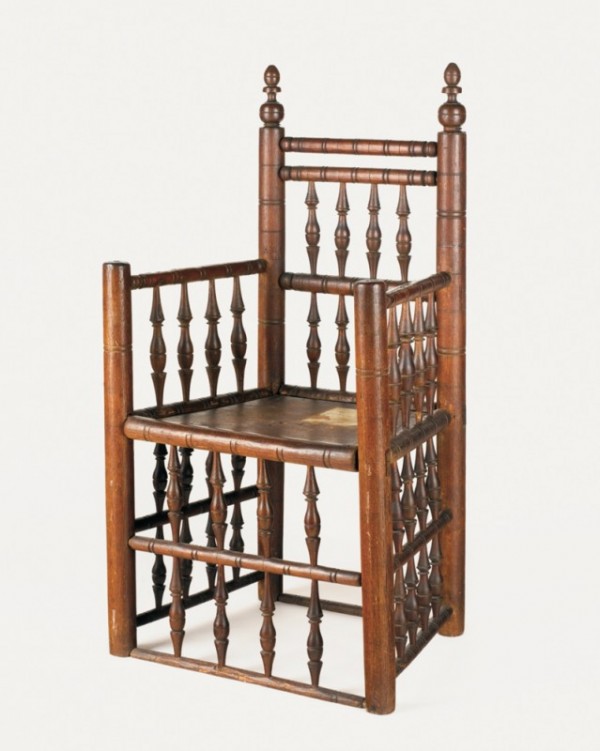
Great chair, Plymouth, Massachusetts, 1640–1660. Ash and pine. H. 45", W. 24 1/2", D. 18 1/2". (Courtesy, Pilgrim Society, Pilgrim Hall, gift of the heirs of William Hedge and Catherine Russell, 1953, phm 1054; photo, Gavin Ashworth.) The seat board and upper back rail are replaced, the front posts may have had pommels, and the feet have been shortened about five inches.

Great chair, Plymouth, Massachusetts, 1640–1660. Ash. H. 45", W. 24", D. 18". (Courtesy, Pilgrim Society, Pilgrim Hall, gift of Daniel Brewster, 1838, PHM 942; photo, Gavin Ashworth.) Fragments of the pommels remain on the front posts. The top back rail, seat board, lower front stretcher, and five spindles are missing.

Great chair, Plymouth, Massachusetts, 1640–1660. Maple and ash. H. 39", W. 26", D. 17 1/2". (Courtesy, Pilgrim Society, Pilgrim Hall, Museum purchase from Roger Bacon, 1967; photo, Gavin Ashworth.) The posts were replaced in the eighteenth century and the spindles replaced at a later date. Tradition maintains that the spindles under the arms came from pews from the 1682 meetinghouse in Hingham, Massachusetts.
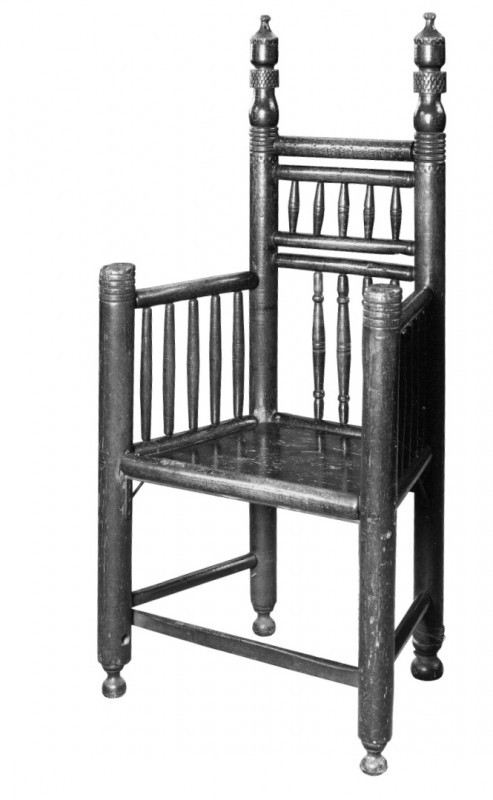
Great chair, probably London or Cambridge, England, 1510–1514. Ash and pine. H. 49", W. 24 5/8", D. 17". (Courtesy, Queens' College, Cambridge; photo, Reeve Photography.) The seat rails have a large rectangular tenon at one end and a small round tenon at the other. The upper back rail is an addition, the front stretcher is replaced, the feet have been pieced out, and the rear stretcher and six spindles under the front seat rail are missing.
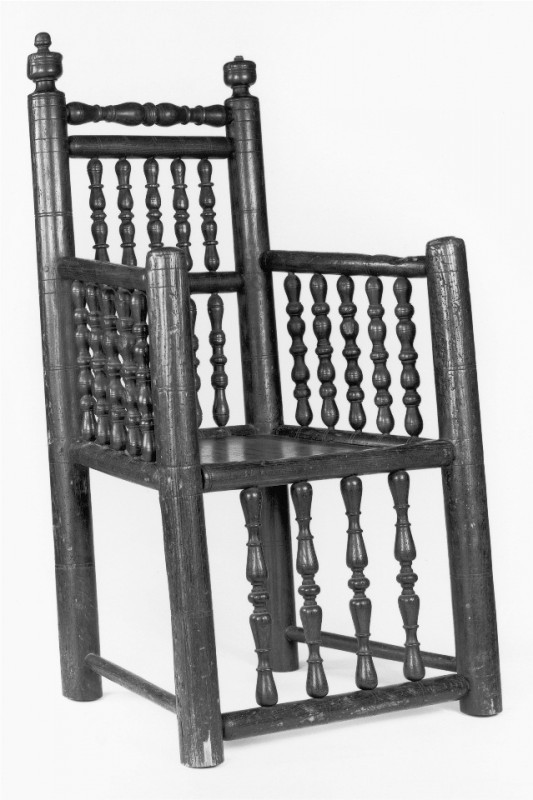
Great chair, England, 1550–1650. Ash and chestnut. H. 43 1/8", W. 24 1/2", D. 17 1/2". (Private collection; photo, Robert J. Bitondi.) The seat board is replaced, the front posts may have had pommels, and the tip of the right finial is missing. The frame never had a lower rear stretcher. The seat construction is the rectangular tenon–small round tenon type.
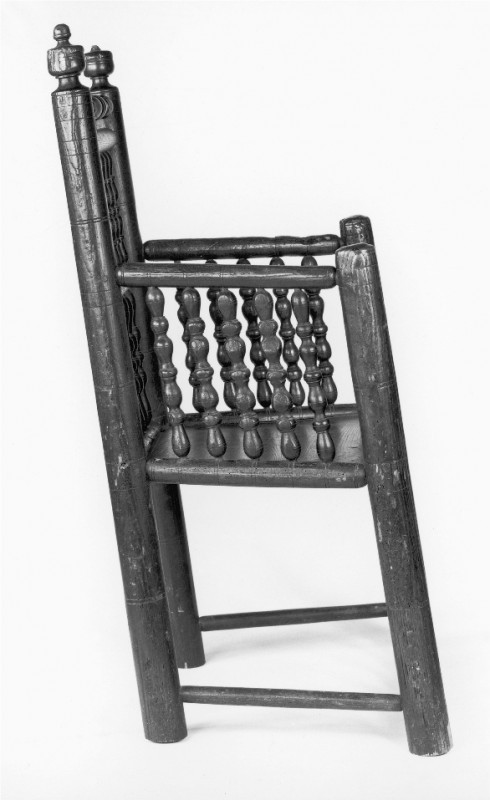
Side view of the chair illustrated in fig. 32, showing the rake of the frame.

Side chair, the Netherlands or southeastern England, 1600–1650. Cherry. H. 30 1/2", W. 17 1/2", D. 14 7/8". (Courtesy, Antiquarian & Landmarks Society, Hartford, Connecticut; photo, Robert J. Bitondi.) The seat board and left stretcher are replaced.

Detail of a spindle on the chair illustrated in fig. 34.
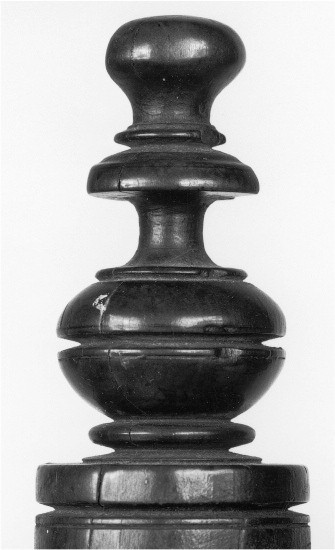
Detail of the left finial of the chair illustrated in fig. 34.
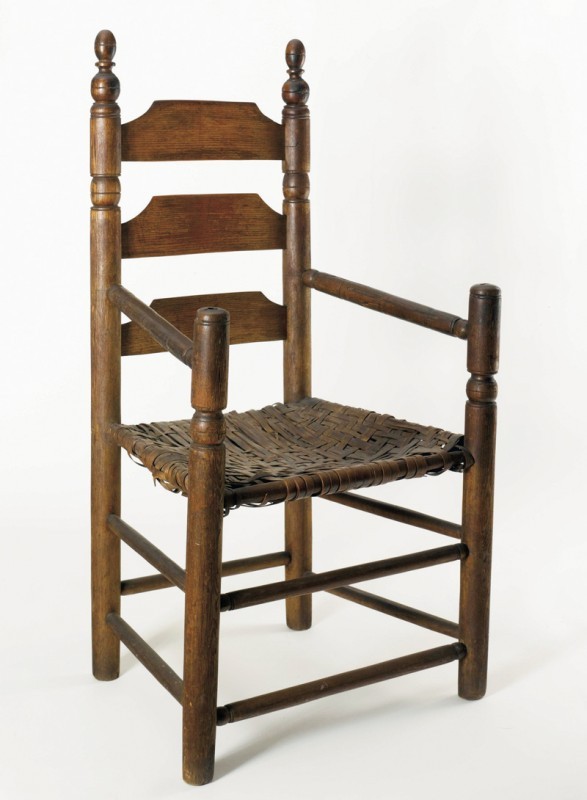
Great chair, Plymouth, Massachusetts, 1660–1690. Maple and ash. H. 45 3/4", W. 24", D. 17 1/2". (Private collection; photo, Gavin Ashworth.) This chair reputedly belonged to William Brewster’s grandson, Benjamin Brewster (1633–1710), who moved from Plymouth to New London, Connecticut, in 1653 and then to Norwich, Connecticut, by 1662.
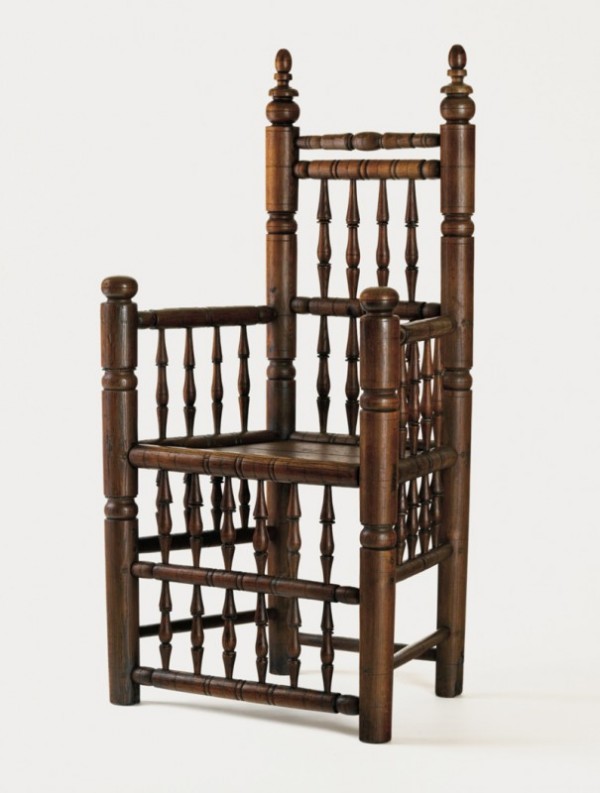
Great chair, probably Boston, Massachusetts, 1640–1680. Ash and oak. H. 44 3/4", W. 23 1/2", D. 15 3/4". (Courtesy, Metropolitan Museum of Art, bequest of Mrs. J. Insley Blair, 1951 [51.12.2]; photo, Gavin Ashworth.) This chair descended in the Tufts family of Medford, Massachusetts. The seat board and pommels are modern replacements.
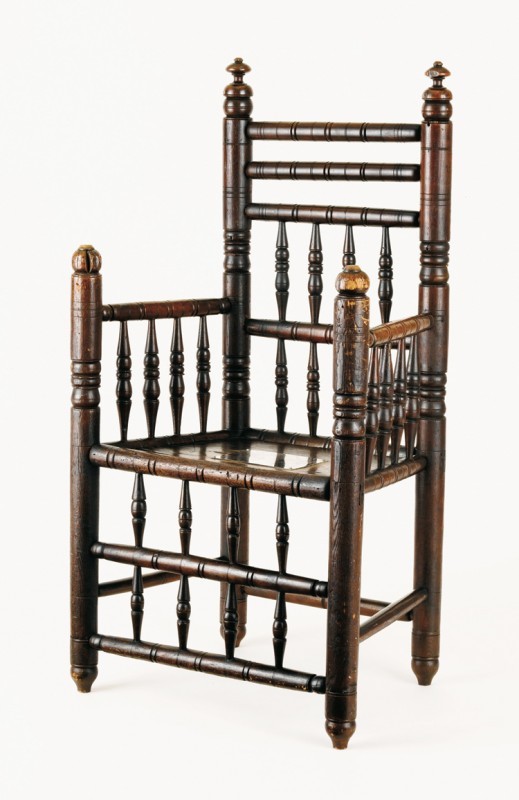
Great chair, probably Boston, Massachusetts, 1650–1690. Ash and oak. H. 43 1/2", W. 24", D. 17 1/8". (Courtesy, Roxbury Latin School, Unitarian Universalist Church in America; photo, Gavin Ashworth.) Rev. Thaddeus Mason Harris (1768–1842) acquired this chair from a Roxbury, Massachusetts, family and gave it to the First Church in Dorchester, Massachusetts. The chair was subsequently transferred to the Unitarian Universalist Church in America and is currently at the Roxbury Latin School. The top back rail is replaced, and the posts are pieced out.
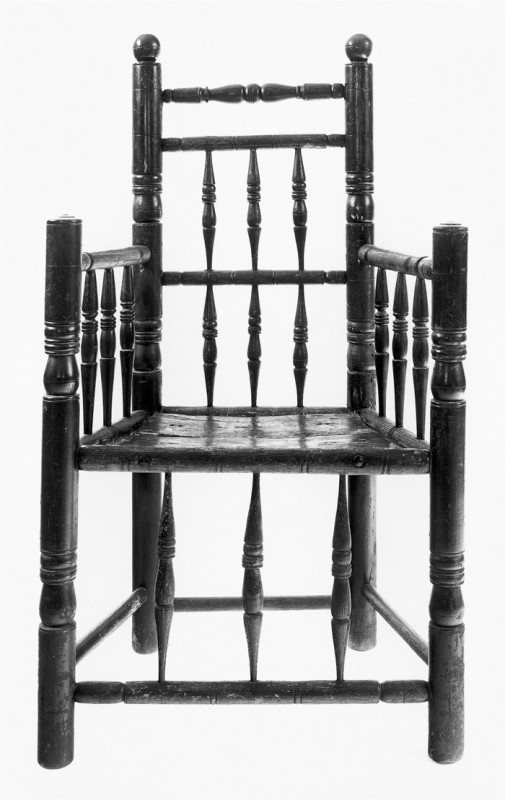
Great chair, probably Boston, Massachusetts, 1660–1690. Ash, maple, and oak. H. 41", W. 21 1/2", D. 15 1/16". (Courtesy, Historic New England, gift of Mary Thacher; photo, Gavin Ashworth.) The rear legs are pieced out below the seat, the spindles beneath the arms and the finials are replaced, and the front posts may be replaced.
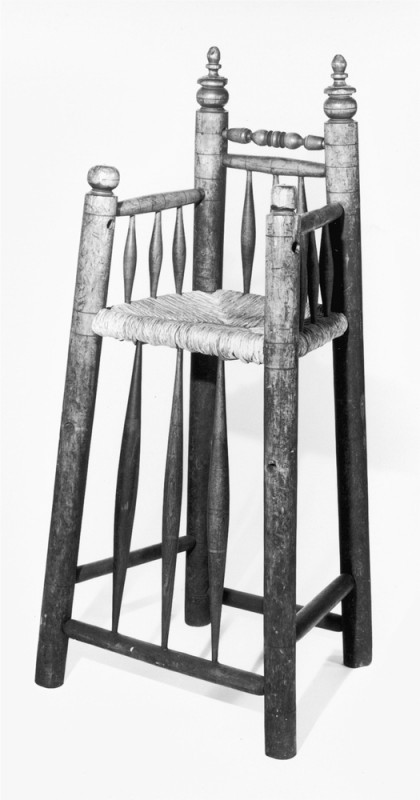
Child’s high chair, probably Boston, Massachusetts, 1660–1700. Maple and ash. H. 38 5/8", W. 18 1/4", D. 14 5/8". (Courtesy, American Antiquarian Society, gift of Mrs. Hannah Mather Crocker.) The seat board and a footboard are missing, the center front spindle is a replacement, and the top back rail may be replaced.
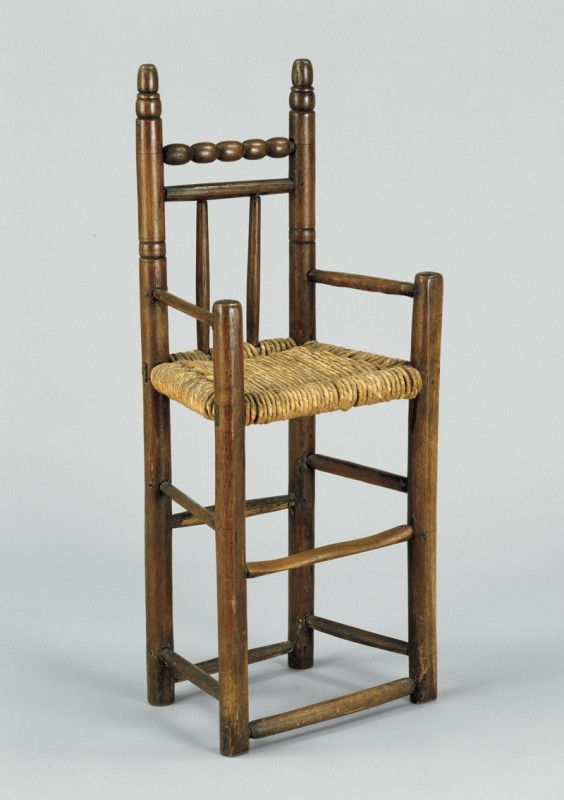
Child’s high chair, Virginia, 1670–1710. Black walnut. H. 36 1/2", W. 14 1/4", D. 11 1/2". (Courtesy, Colonial Williamsburg Foundation; photo, Hans Lorenz.) This chair may have belonged to Hancock Lee (1653–1709) of Virginia. The seat board, footboard, and seat board are missing. Both right stretchers, both rear stretchers, both back spindles, and the lower back rail are replacements.

Great chair, probably Boston, Massachusetts, 1660–1700. Maple and ash. H. 41 3/4", W. 24", D. 19 1/2". (Courtesy, Museum of Fine Arts, Boston, bequest of Charles Hitchcock Tyler.) The left back spindle and the front two inches of the seat are replaced, and the posts are pieced out at the bottom.
